Quick Facts
Biography
Sir William Reid Dick KCVO RA (1879–1961) was a Scottish sculptor known for his innovative stylisation of form in his monument sculptures and simplicity in his portraits. He became an Associate of the Royal Academy in 1921, and a Royal Academician in 1928. Dick served as president of the Royal Society of British Sculptors from 1933 to 1938. He was knighted by King George V in 1935. He was Sculptor in Ordinary for Scotland to King George VI from 1938 until his death.
Early life
Born in Glasgow, Dick was apprenticed to a stonemason at the age of twelve and during the next five years he learned to carve stone at work, and at night took drawing and modelling classes. He completed his apprenticeship in 1896. In 1907, he graduated from the Glasgow School of Art and accepted a teaching position at Bellshill Academy in Lanarkshire. By 1908 he was living in London and exhibiting in galleries and took evening classes at South London Technical School of Art whilst working for the sculptor Edwin Whitney-Smith.
War service
In September 1914 with his reputation as a sculptor growing, Reid Dick joined the Territorial Army and from 1915 to 1919 served with the Royal Engineers in both France and Palestine. Reid Dick's Service Record has fortunately been preserved as part of the "Burnt Records" series at the National Archives in Kew and can be found under reference WO 363/MIS-SORTS 34/52. From this file we learn that when Reid Dick signed up on 1 September 1914 he joined the 5th London Field Ambulance section of the Royal Army Medical Corps with regimental number 1752. He was 34 years and 4 months of age and gave his address as 1 St John's Wood Studios, Queens Terrace, St John's Wood. His wife Catherine was shown as "next of kin". Reid Dick subsequently transferred to the 3rd Army Field Survey Co, part of the Royal Engineers and then the 7th Field Survey Co. He was in this period allocated regimental numbers 536331 and 244831. He was described as a photographer with the 7th Field Survey Co. His Army Service record shows his profession as "sculptor". We can also view his Medal Index Card under reference WO 372/6-52934/2976 [1]. We see that he was awarded the 1915 Star and the British and Victory Medals. Interesting to note that his medals were engraved with the Royal Army Medical Corps shown as his corps rather than the Royal Engineers.
Whilst in the trenches Reid Dick did many small carvings from chalk. A story is told that a padre, touring the trenches, saw Reid Dick at work, and by way of a compliment told Reid Dick that he might well consider taking up carving as a hobby. As we now know William Dick Reid was to become a foremost sculptors.
Life after military service
Dick did indeed fulfil the padre's prophecy and produced several superb works. Reid Dick designed several war memorials and received a major commission for the Kitchener Memorial Chapel (1922–25) in St Paul's Cathedral, London. The focal point of his design for the chapel was a Pièta, which won a gold medal at the Paris International Exhibition of Modern Decorative and Industrial Arts in 1925. This work secured his reputation and election to the Royal Academy. Throughout his career, Reid Dick worked tirelessly both in the studio and serving on numerous committees, among these the Royal Fine Art Commission (1928–42), the Royal Mint Advisory Committee (1936–53), and the Board of Trustees of the Tate Gallery (1934–41). In addition he was President of the Royal Society of British Sculptors between 1933–37.
His archives are held by the Tate Gallery and he was buried in St. Paul's Cathedral, London.
Main works
| Name | Location | Comments | Image |
|---|---|---|---|
| Rickmansworth War Memorial | Rickmansworth Hertfordshire | Part of Rickmansworth's original war memorial is now in the churchyard of St Mary's Church in Church Street and the other part is in Three Rivers Council Office Gardens. Originally what was a cenotaph-type structure was located in Ebury Road but when major changes were made to that road and the junction with the Uxbridge Road to create the Ebury Roundabout, the main structure was moved to St Mary's and the Lion and Eagle which had stood on top of that structure was moved to Three Rivers Council Office Gardens. The memorial in St Mary's churchyard is inscribedIt has a seated woman at both the north and south faces, one symbolising the sorrow and despair of 1914, and the other the hopeful triumph of 1918. It was originally designed to have a pyramid cap on top, but this design was amended to include the statue of a lion with its paws holding down an eagle. A pyramid cap was finally substituted in June 1968. 194 names are listed on the cenotaph these of men who were killed in the First World War with a further 82 names of men killed in the Second World War. The entire memorial was first moved in 1940 to avoid damage from German bombing and reinstated in 1951 but a further dismantling was necessary in 1968 when the move from Ebury Road took place. At Northway the inscription reads The memorial in Northway comprises a brick plinth on which Reid Dick's sculptured group of a lion with its paws holding down an eagle is placed. |  |
Images Rickmansworth Lion and Eagle sculptures
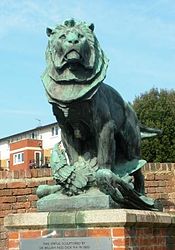
Sculpture of Lion Rickmansworth
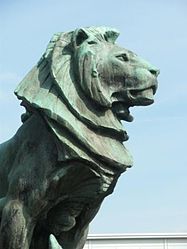
Sculpture of Lion Rickmansworth

Sculpture of Eagle Rickmansworth
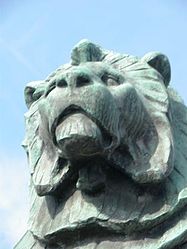
Sculpture of Lion Rickmansworth

The Rickmansworth Cenotaph
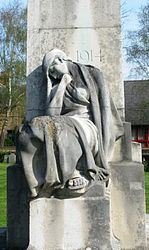
Sculpture of Grief from Rickmansworth Cenotaph. Churchyard of St Mary's Church.
| Name | Location | Comments | Image |
|---|---|---|---|
| Bushey War Memorial | Bushey Middlesex | Situated at the junction of Sparrows Herne and School Lane in Bushey this sculpture by Reid Dick is arguably one of the most moving of all the many war memorials in England! The inscription readsThe memorial comprises a plinth in Portland stone upon which stands Reid Dick's sculpture of a woman in mourning. Her head is bowed and her left hand is placed under her chin. The figure holds a laurel wreath in her right hand. 157 Bushey men who were killed in the First World War are remembered and a further 83 names are listed of those killed in the Second World War. |  |
Images Bushey War Memorial
| Name | Location | Comments | Image | ||||
|---|---|---|---|---|---|---|---|
| Chapel of All Souls (Kitchener Memorial Chapel) | St Paul's Cathedral City of London | Reid Dick worked on the Kitchener Memorial in what is now known as The Chapel of All Souls in St Paul's Cathedral. After Kitchener's death when the "Hampshire" was sunk in June 1916, a "Kitchener Memorial Committee" was formed to choose and organise a fitting tribute to his life and achievements and the Kitchener Memorial Chapel was selected. The memorial includes a Pieta and the figures of the Warrior Saints St Michael and St George and a recumbent Lord Kitchener in white marble, all the work of Reid Dick. At Kitchener's head is a tablet on the wall which readsand next to the effigy itself is another inscription Image shown right courtesy Tony Worrall and that in gallery below courtesy Alexander Gordon. Reid Dick also worked on the Queen Alexandra's Imperial Nursing Service Memorial Tablet in the Kitchener Memorial Chapel |  | ||||
| Horlicks Limited War Memorial | Slough Berkshire | This memorial is located in the grounds of the Horlick's factory in Stoke Poges Lane, Slough. Reid Dick's sculpture for this memorial is a bronze figure of a woman in an attitude of grief. The memorial is dedicated to the 7 employees of Horlicks who gave their lives in the First World War. | |||||
| The Royal Air Force Memorial | Westminster Greater London | This memorial is located on the Victoria Embankment and comprises a stone column surmounted by a large globe on which Reid Dick has sculpted a gilt eagle with wings upstretched and facing towards the Thames. The memorial's inscription readsThis memorial was unveiled in 1923 by the Prince of Wales. His speech included the prophetic description of the RAF as "our cloud armies of the future". The Royal Air Force Memorial was designed by the architect Sir Reginald Bloomfield. | |||||
| The Angus Watson and Co.Ltd War Memorial | Newcastle upon Tyne Tyne and Wear | Reid Dick carried out the sculptural work on the memorial to the employees of Angus Watson and Co Ltd who gave their lives in the First World War. | |||||
| Sculpture of Franklin Delano Roosevelt | Grosvenor Square Greater London | Reid Dick was commissioned to sculpt this statue of Franklin Delano Roosevelt. |  | ||||
| Statue of George V | Westminster London | This statue stands opposite the Houses of Parliament and it was unveiled by George VI on 22 October 1947. File WORK 20/279 at The National Archives in Kew covers the appointment of Reid Dick and the architect Sir Giles Gilbert Scott to be responsible for this memorial and other files WORK 20/201, WORK 20/202, WORK 20/203 and WORK 20/278 all give background information on the work. The completion of the scheme was delayed by the outbreak of war in 1939. The statue was stored during the war in the quarry at Portland and returned to London in 1946. The statue was unveiled in 1947. |  | ||||
| Sculpture Lady Godiva | Coventry | Reid Dick was the sculptor of this work in Coventry. On the plinth below the statue are written some words from Tennyson's poem "Lady Godiva"
|  | ||||
| Sculpture Controlled Energy | Reid Dick created two sculptures for Unilever House. They are positioned at each end of the building's facade and each depict a large shire horse being reined back. It is as though the strength of the two horses would pull the building apart but for the effort of those pulling them back. |  | |||||
| The Arras Memorial | Arras | The National Archives at Kew have several files on this memorial. File AIR 1/677/21/13/1891 contains a draft of the Introduction to the Register of the Imperial War Graves Commission (now the Commonwealth War Graves Commission) written by their Director of Records, Major H.F. Chettle. Chettle's covering letter is dated 18 March 1930. Reid Dick sculpted the globe on top of the Arras Flying Services Memorial which is to be found at the Arras Cemetery in Northern France along with the Arras Memorial. A photograph of this memorial is shown below. Reid Dick carved both the badges on the memorial and the great globe, which is 4-foot 6 inches in diameter and weighs almost three tons. The memorial consists of an obelisk with a globe forming a finial on the top. The badges are those of the Royal Flying Corps, Royal Air Force, Royal Naval Air Service, and the combined badges of Canada, Australia, New Zealand and South Africa. The two memorials and cemetery, the work of Sir Edwin Lutyens, are situated in the western part of Arras. The Arras Memorial commemorates almost 35,000 servicemen from the United Kingdom, South Africa and New Zealand who died in the Arras sector between the spring of 1916 and August 1918, the eve of the so-called "Advance to Victory" and who have no known grave. The Arras Flying Services Memorial commemorates nearly 1,000 airmen of the Royal Naval Air Service, the Royal Flying Corps and the Royal Air Force either by attachment from other arms of the forces of the Commonwealth or by original enlistment, who were killed on the Western Front and who also have no known grave. | - | The Menin Gate Memorial | Ypres Belgium | Reid Dick sculpted the decorative features which adorn the Menin Gate at Ypres, including the lion at the very top. The Menin Gate marks the start of one of the main roads leading from Ypres (Ieper) to the Front Line; the infamous "Menin Road". The gate combines a classical victory arch and mausoleum. Inside and outside are carved the names of 54,896 officers and men of the Commonwealth forces who died in the Ypres salient and have no known grave. The Menin Gate was not in fact big enough to record all the names so was limited to those who died from the outbreak of war to 15 August 1917. The names of the further 34,888 men who died from 16 August 1917 to the end of the war and again have no known grave are recorded on the Tyne Cot Memorial. |  |
| Memorial to David Livingstone | Victoria Falls Zimbabwe | Reid Dick was the sculptor of the memorial to David Livingstone. |  | ||||
| Memorial to Lord Levershulme | Port Sunlight Merseyside | This Reid Dick sculpture stands outside the Lady Lever Art Gallery at Port Sunlight. Reid Dick's figures at the base of the obelisk represent "Industry", "Charity", "Education" and "Art". The figure on the top of the obelisk, looking to the sky with outstretched arms represents "Inspiration". This memorial was completed in 1930 and honours William Hesketh, the first Viscount Leverhulme who founded Lever Brothers Limited. |  |
Other work
Reid Dick was also the sculptor of-
- Bas-reliefs for Selfridges store in Oxford Street, London.
- Figures for St Andrew's House in Edinburgh.
- The bronze Herald for the Reuters Building in Fleet Street, London.
- A figure above the entrance to Adelaide House, London Bridge. The figure is in drapes and holds an orb with a bronze astrological band.
- The Tate Gallery has a bronze mask of a man entitled Androdus by Reid Dick, and the National Portrait Gallery has a Reid Dick bust of Lord Duveen.
- Statue of Sir John Soane. North wall of the Bank of England. Threadneedle Street, London EC2
- Harry Dwight Ripley Monument. St. Marylebone Cemetery and Crematorium.
Photographs of statues
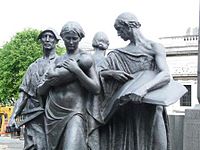
Part of Lord Levershulme Memorial at Port Sunlight

Eagle on RAF Memorial

Reid Dick's sculpture of Lady Godiva.
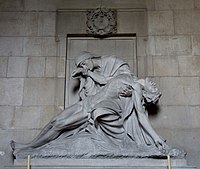
Pieta in St Pauls Cathedral-Kitchener Memorial Chapel
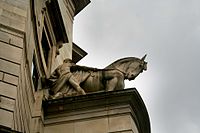
Sculpture of a man and horse at Unilever House, Controlled Energy, 1933, left side

Controlled Energy, sculpture of a woman and horse at Unilever House, right side
Left view of Controlled Energy
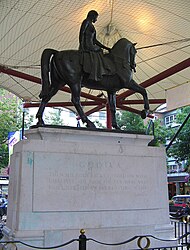
Statue of Lady Godiva on a horse, Broadgate, Coventry, England.
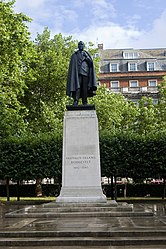
FDR statue, Grosvenor Square
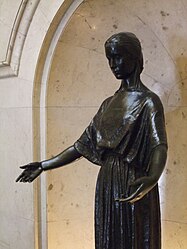
Statue entitled Welcome, in Nottingham Council House



















